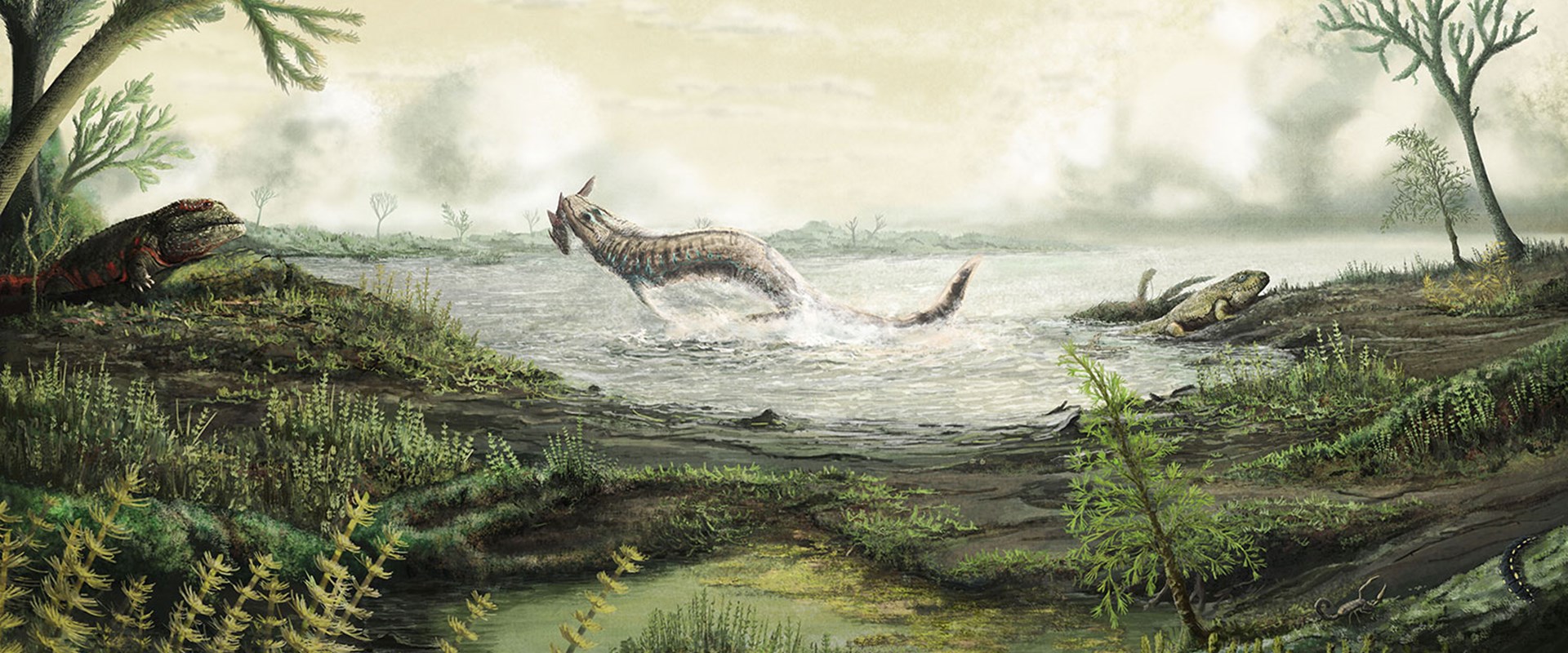Fossil Hunters: Unearthing the Mystery of Life on Land
Friday 19 February - Sunday 14 August 2016
National Museum of Scotland, Chambers Street, Edinburgh
ADMISSION FREE
A collection of Scottish fossils which solve the mystery of how vertebrate life came to move from water to land will be displayed in a new exhibition at the National Museum of Scotland entitled Fossil Hunters: Unearthing the Mystery of Life on Land.
These groundbreaking finds from the Scottish Borders fill a major gap in our understanding of evolution. Until recently, there was very little fossil evidence of life on land during the early Carboniferous period, around 345-360 million years ago. This was a pivotal moment in evolution, when vertebrate life moved from the sea to the land; a momentous shift without which humans would not exist today.
This 15-million-year missing link is named “Romer’s Gap” after the American palaeontologist Alfred Sherwood Romer, who identified it. Without evidence to the contrary, some palaeontologists concluded that low levels of oxygen during this period restricted evolution on land. However, these fossils confirm that a rich and diverse ecosystem of amphibians, plants, fish and invertebrates thrived during this period. Most importantly, they address one of palaeontology’s big unanswered questions, that of how vertebrate life crawled out of the water.
Visitors to the exhibition will have the opportunity to discover how amphibians took their first steps on to land and why this is such an important milestone in the evolutionary timeline. They will also be able to find out about the techniques used to unearth the fossils and what the extensive analysis of the finds tell us about life on land before the dinosaurs.
Nick Fraser, Keeper of Natural Sciences at National Museums Scotland said:
“National Museums Scotland holds one of the finest collections of fossils of early, land-based life in the world. Solving the mystery of this evolutionary missing link is hugely exciting, and has allowed us to gain a rich understanding of a key period in the evolution of life on earth. This fascinating exhibition will explore in detail for the first time the full story of this remarkable discovery.”
Long before vertebrates evolved legs, there was already life on land. The earliest known terrestrial ecosystem in the world is preserved in a bed of sediment in Aberdeenshire called Rhynie Chert. This 410-million-year-old rock contains plants, spiders and the oldest-known fossil insects.
However, there was no evidence of tetrapods (vertebrates with four limbs) on land. Fossil evidence pre-dating Romer’s Gap showed tetrapods living in the water 360 million years ago, but their limbs were not strong enough to support them on land. 15 million years later, ample evidence of tetrapod life on land can be found, by which point amphibians were well-adapted to walking. Palaeontologists could only speculate as to how and why the monumental step from water to land was taken.
The late Stan Wood, a self-taught Scottish field palaeontologist, was convinced that fossil evidence of tetrapod life during Romer’s Gap could be found in Scotland, and spent 20 years searching for it. Finally, in 2011, he uncovered never-before-seen fossil evidence of early tetrapod life on land - fossil animal skeletons, along with millipedes, scorpions and plants- at the Whiteadder River, near Chirnside.
These finds – some of which were displayed at the National Museum of Scotland in 2012 - were the catalyst for a major research project which set out to uncover further evidence of tetrapod life on land during the earliest Carboniferous period, and to analyse the findings. Fossil Hunters also presents subsequent fossil finds and detailed analysis alongside Stan Wood’s extraordinary discoveries.
The research behind the exhibition is part of a major grant funded by the Natural Environment Research Council and the Heritage Lottery Fund, with research conducted by National Museums Scotland in partnership with the Universities of Cambridge, Southampton and Leicester as well as the British Geological Survey.
Further information and images from Alice Wyllie, Bruce Blacklaw or Susan Gray, Press Office, National Museums Scotland on 0131 247 4288 or email a.wyllie@nms.ac.uk
Notes to editors
- National Museums Scotland looks after museum collections of national and international importance and provides loans, partnerships, research and training in Scotland and internationally. Our individual museums are the National Museum of Scotland, the National Museum of Flight, the National Museum of Rural Life and the National War Museum. The National Museums Collection Centre in Edinburgh houses conservation and research facilities as well as collections not currently on display.
- The National Museum of Scotland reopened in summer 2011 following a three-year, £50m redevelopment. With over 8 million visitors since reopening, the National Museum of Scotland is the most popular museum in the country outside of London according to ALVA figures.

